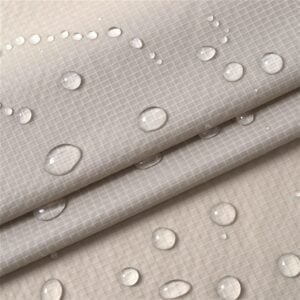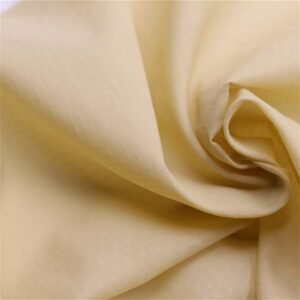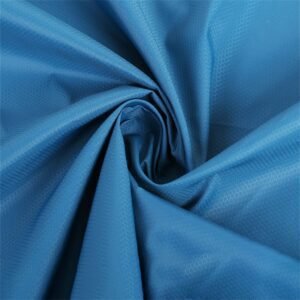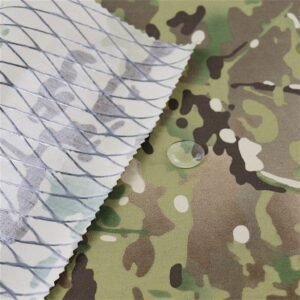Ripstop Nylon,Ripstop Polyester,Ripstop Stretch fabric
Ripstop fabric stands out in the textile world for its exceptional strength and durability. As the name suggests, this fabric is specifically designed to resist tearing, making it a popular choice for outdoor gear and military applications. Originally developed for military use, ripstop fabric was used in parachutes during World War II. Traditional fabrics often ripped, posing a significant risk to soldiers in combat. Ripstop fabric was created to solve this problem.


Advancements in technology have further enhanced the performance of this fabric, which is now a staple material for outdoor gear and industrial applications. This article will explore the characteristics, production process, and common uses of ripstop fabric.
What is Ripstop Fabric?
The uniqueness of ripstop fabric lies in its reinforced weave. It incorporates thicker, stronger fibers like nylon or polyester into the fabric, forming a grid-like pattern. This distinctive weave helps prevent tears from spreading beyond the reinforced grid, significantly improving durability and longevity. Tear strength tests, such as EN ISO 13934-1 (ISO 13937-1), have shown that ripstop fabrics can have 30% to 50% higher tear strength than standard fabrics. Consequently, they are often chosen for challenging environments.
Key Features of Ripstop Fabric
Ripstop fabrics are known for their combination of durability, strength, and lightness. Their key attributes include:
- Tear Resistance: The fabric is reinforced with a grid pattern of thicker yarns that help prevent small tears from becoming larger.
- Abrasion Resistance: The reinforced grid also makes the fabric ideal for high-friction areas or rough surfaces.
- Lightweight: Despite its strength, ripstop fabric remains lightweight, making it suitable for applications where weight is a concern, such as outdoor gear, tents, and parachutes.
- Other Features: Additional qualities like colorfastness, breathability, and quick-drying make this fabric ideal for uniforms and workwear.


How is Ripstop Fabric Made?
Ripstop fabric is produced using a specialized weaving technique designed to provide excellent tear resistance. While the specific processes may vary slightly among manufacturers, the fundamental technique of incorporating a grid pattern with reinforced yarns is consistent.
Types of Materials
- Nylon and Polyester: Common fibers used in ripstop fabrics due to their strength, durability, and lightweight properties. Nylon 6.6 is particularly favored for military gear and high-end outdoor equipment.
- Cotton: Although less common, cotton ripstop fabric offers a natural and breathable alternative, combining tear resistance with the comfort and moisture absorption of cotton.
- Blended Yarns: Polyester-cotton blends are widely used, offering improved durability with three times the strength of pure cotton.
- Composite Fabrics: Ripstop fabric can also be made by blending different synthetic fibers, such as nylon/polyester blends that combine nylon’s strength with polyester’s wrinkle resistance and colorfastness.
Weave Patterns
Ripstop fabric consists of two sets of interlaced yarns: warp (vertical) and weft (horizontal). These yarns are typically thicker and stronger than regular warp and weft yarns and are woven into a grid structure. The fabric usually features a simple square or diamond pattern, where the reinforced yarns intersect. Over time, variations such as rectangular, honeycomb, and other intricate designs have emerged, enhancing both performance and aesthetic appeal.
Common Uses of Ripstop Fabric
Due to its high strength, tear resistance, and lightweight properties, ripstop fabric finds extensive use across various industries. Common applications include:
- Outdoor Gear: Often used in outdoor gear such as backpacks, tents, and sleeping bags due to its ideal properties for outdoor activities.
- Military Equipment: Widely utilized in military and tactical gear, including uniforms, backpacks, and vests designed for harsh environments.
- Parachutes: The tear-resistant quality of lightweight nylon fabric is crucial in parachute production, providing strength while ensuring a safe, controlled descent during jumps and aerial activities.
- Sails and Kites: The fabric’s ability to withstand strong winds and handle tension makes it popular for sails, windsurfing, and kite surfing.
- Luggage and Bags: Ideal for making suitcases, travel bags, and backpacks due to its abrasion resistance and tear strength, ensuring durability and content protection.
- Clothing: Used in apparel like shirts, shorts, pants, and jackets, ripstop fabric is favored for its quick-drying, breathable, and durable properties.
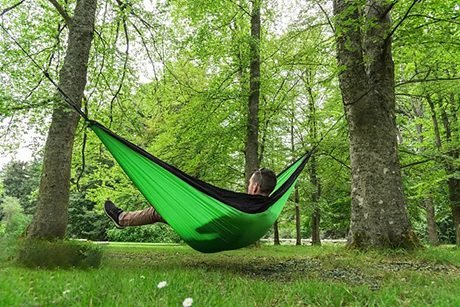





Advantages and Disadvantages of Ripstop Fabric
Advantages
- High tear resistance
- Lightweight with excellent strength
- Superior breathability and moisture-wicking properties
- Tight structure and firm texture
- Comfort and flexibility when blended with elastic fibers
FAQs
Is Ripstop Fabric Waterproof?
The fabric itself is not inherently waterproof but can be treated or coated to improve water resistance. Outdoor apparel fabrics can also be made waterproof by laminating them with breathable membranes. The degree of water resistance depends on the type and quality of the treatment.
Is Ripstop Fabric Stretchy?
Common ripstop fabrics have minimal stretch, focusing primarily on strength, durability, and tear resistance rather than elasticity. However, the stretchiness can vary depending on the specific fibers used and any additional treatments, such as with T400 stretch ripstop fabric or spandex-blended versions.
Is Ripstop Fabric Easy to Clean?
Yes, this fabric is generally easy to clean, but specific cleaning methods may vary based on the fiber content. Treatments like water or oil repellent finishes can add stain resistance and ease of cleaning. Most ripstop fabrics, especially those made from synthetic fibers, are machine washable, though delicate fabrics may require hand washing. Always check the care label or manufacturer’s instructions for the recommended cleaning methods and precautions.
Is Ripstop Fabric Suitable for Hiking?
Absolutely! Ripstop fabric is an excellent choice for hiking due to its durability, lightweight, quick-drying, fade resistance, and tear-proof qualities. However, when selecting a ripstop fabric for hiking, consider the climate and terrain, ensuring that the other features align with the conditions you may encounter.
Ripstop Polyester vs. Ripstop Nylon
Both polyester and nylon ripstop fabrics are known for their durability and strength. From a weight and moisture absorption perspective, ripstop nylon is often a better choice, while ripstop polyester offers better colorfastness. Ripstop polyester is generally more cost-effective than ripstop nylon.
By understanding the unique properties of ripstop fabric, you can select the most suitable option for your needs, whether for outdoor adventures, tactical missions, or everyday wear.
-
Легкая ткань в клетку из нейлона 66 20D Ripstop
-
Ткань жаккардовая клетка Ripstop Nylon 20D
-
Сотовая решетчатая ткань Ripstop Nylon 40D
-
Смесовая клетчатая ткань Cordura N/C 50/50 Ripstop из хлопка
-
Ткань простирания хлопка полиэстера Т400 Рипстоп материальная для прозодеждов
-
Тусклая нейлоновая ткань Ripstop Taslan 5*6 мм в клетку Etaproof
-
Высокопрочная ламинированная ткань MULTICAM из нейлона Cordura Ripstop 500D
-
Высокопрочная нейлоновая ткань 66 70D Stretch Ripstop
-
Ткань рипстоп в клетку из нейлона 66 ATY толщиной 0,8 см, 700D
